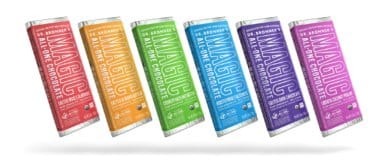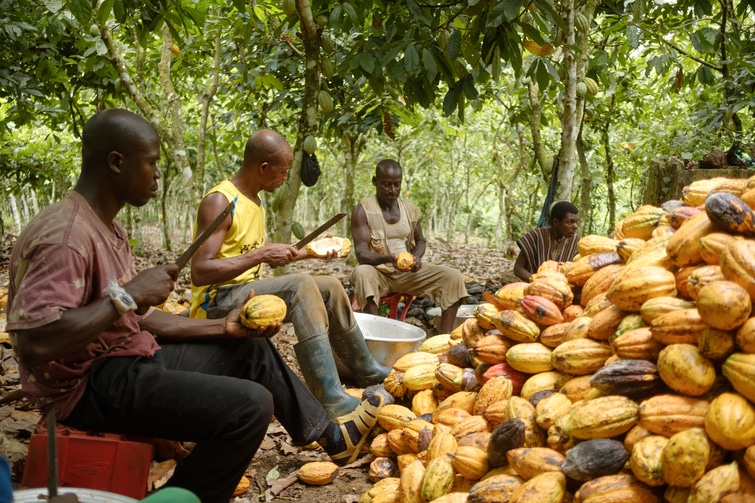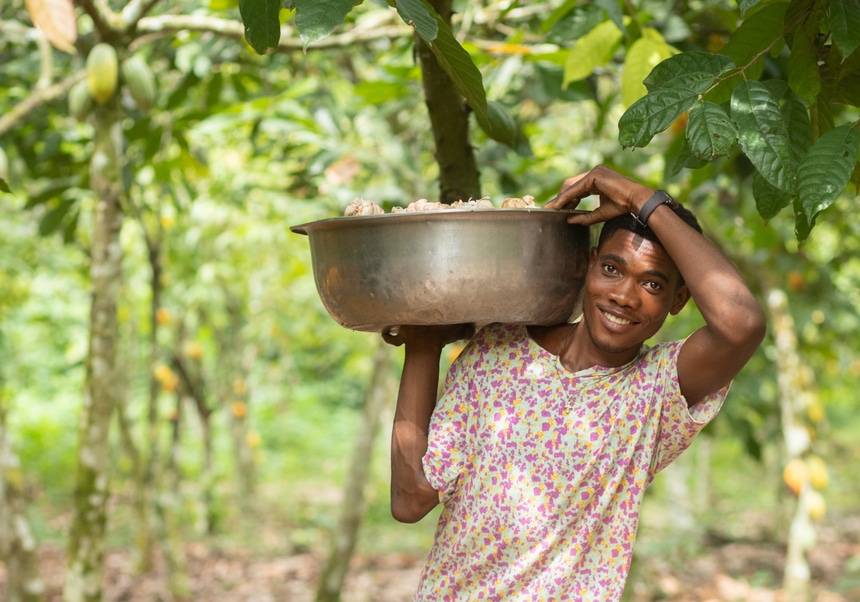Magic All-One Chocolate!

Click here to learn about all 6 flavors – what they taste like and where to buy them
The following post is an abridged excerpt from my book Honor Thy Label: Dr. Bronner’s Unconventional Journey to a Clean, Green, and Ethical Supply Chain.
On my first drive to Asuom, Ghana in late 2006, in an area that would eventually be host to our organic and fair trade palm project Serendipalm, I met a new plant. In the bush next to the road I discovered a grove of trees that carried, on their trunks and major branches, ovoid fruits the shape of an American football, though about half its size. Held only by short connectors, they grew in clusters, with colors ranging from mottled green through deep yellow to a beautiful dark orange. I had not seen anything like it.
“What are they?” I asked our driver, Collins.
“Cocoa,” he said. “It’s peak harvest season.”
Yet another crop whose products I had consumed for years without bothering to think about where and how it grew! But it didn’t take long to develop a working relationship with the plant that grows chocolate. We would learn, even before we first purchased our first palm fruits in 2008, that many of our oil palm farmers also grew other tree crops, such as cocoa and citrus, and field crops, including cassava (manioc) and maize. We knew because farmers in an organic Internal Control System (ICS) must report all plots they farm, organic or not.

Virtually all cocoa in the area was grown with a strong dose of synthetic pesticides, which are prohibited in organic production. It was obvious. Driving to and from palm fields, we would see farmers and farmworkers on their way to spraying their cocoa, carrying yellow canisters featuring hoses and spray nozzles. We would see them in the field, where they handled the toxic chemicals rather casually. Many farmers are not aware of the health risks and were told by suppliers and government extension services that there is no viable alternative.
Why didn’t we immediately persuade cocoa farmers to abandon the use of pesticides, convert their cocoa fields to organic production, and find customers for these beans? After all, organic and fair cocoa beans fetch premiums of typically $500 per metric ton, depending on origin and quality. And cocoa would have diversified Serendipalm’s operation.
We avoided such an early entry into organic cocoa for two main reasons. One, we were preoccupied with the challenges of building a functioning oil palm system. The second reason goes to the heart of the complex trouble that cocoa production finds itself in in West Africa, by far its largest producing region worldwide.
To understand why, let’s explore a bit of cocoa’s history.
Not a Happy Crop: Cocoa’s Troubled History
The cocoa plant originally hails from Central and South America, where it was highly valued in pre-Columbian times and where much of the world’s cocoa is still grown. The Spanish conquistador Cortez brought cocoa and the knowledge of its use by the Aztecs back to the Spanish court. The bitter taste prevented an immediate boom, but by the 1540s, adding sugar or honey produced a pleasurable and stimulating beverage. It was a luxury drink, for sure.
Colonizers grew cocoa, first using enslaved indigenous people. After decimating their populations through disease and violence, plantation owners turned to West African slaves. More cocoa production shifted from Central to South America, mostly the Atlantic side, which was easier to reach by ships bringing slaves from Africa and taking cocoa to Europe.
Since the 1970s, the two neighboring West African countries of Ivory Coast and Ghana, with their suitable soils and climate and a solid foundation of cocoa experience under British and French colonial rule, gradually became the largest cocoa-producing area on earth. Combined, they now produce over 60 percent of the global crop of dry cocoa beans.

In the 1980s, escalating cocoa prices drove large planting campaigns, reflecting the world’s growing appetite for chocolate products. A great opportunity for West African smallholders, yet the story didn’t pan out as farmers and their governments had hoped.
West African farmers often planted their cocoa trees hastily, the quality of seedlings was poor, and many farmers broadcast seeded (scattering seeds by hand). This created orchards with tree densities of 1,500 to 2,000 cocoa trees per hectare, much higher than the 1,100 to 1,300 considered optimum for a cocoa monoculture.
Farmers also routinely omitted the planting of recommended shade trees; and once trees had grown up, they stopped pruning and thinning them out, fearing that would reduce bean yields. Weeding and harvesting was often their only maintenance. Yet densely planted unpruned trees make for poorly ventilated orchards, very susceptible to attack by insects, such as mirids or capsid bugs, or by the Phytophthora fungus, which forms black mold that destroys the infected pods.
The overall result was miserably low cocoa yields. Such typical conventional smallholder fields in Ghana now yield between 350 and 400 kg/ha of dry beans. Compare this with the 800 to 850 kg/ha average yields when planting from quality seeds or seedlings at the right density, including shade trees, and maintaining crops with the modest use of agrochemicals. Simplistically, this is at the core of the poor state of Ghanaian cocoa farming.
To control the quality of a promising export commodity, the British colonial government had created, in 1947, the Ghana Cocoa Marketing Board. Later renamed Cocobod, it took control of the purchasing and marketing of cocoa beans and gave Ghana cocoa a reputation for quality.

Cocobod then sells the beans to cocoa importers worldwide, naturally at a profit. Seemingly, that approach worked well; today cocoa beans from Ghana are considered of good quality, widely used in commodity and specialty chocolates, and fetch a modest premium over the world market price. Farmers benefited from guaranteed sales of their entire production at reasonably stable producer prices.
Yet Cocobod did not address the underlying agricultural problems that caused low yields in the first place. Increasing pest attacks coincided with the collapse of the world market for cocoa. The extensive global planting had driven up production faster than demand grew. Thus, nominal global cocoa prices crashed from $4,400 per MT in 1977 to between $900 and $1,500 per MT through most of the 1990s—great for buyers in the West, terrible for cocoa growers.
Rather than attacking the cause of the problem by helping farmers to thin out, prune, and replant trees, Cocobod placed its bets on agrochemicals, notably pesticides. It began issuing free insecticides and copper-based fungicides.
Was it a successful program? It sure helped raise exports of Ghana cocoa from 200,000 MT in 1985 to 815,000 MT in 2018. Yet it didn’t solve—and instead further contributed to—the underlying agricultural problems. Ghanian farmers with low-yielding cocoa fields still make little, if any, money once you figure in all costs. Naturally, farmers will continue to harvest since the beans now grow “for free,” but many can’t afford to spend money on the replanting and pruning needed to improve yields: the dreaded low-yield trap.
Moreover, many cocoa farmers are aging and not fit for demanding fieldwork. Without external support their farms are condemned to minimum farm maintenance and spraying of free pesticides, with many farms engaging child labor, usually their own, as workers to save on cost. In Ivory Coast and Ghana, farmers hoping for a future price increase have even planted many new cocoa plots illegally into protected forests.
Could all this be true? That more than half of the world’s chocolate is made from cocoa beans largely grown in jam-packed, poorly maintained farms—sometimes planted illegally on supposedly protected land? That these farms show poor bean yields and are barely profitable? That farmers use pesticides rampantly, often carelessly, and child labor is prevalent in some areas to help farmers get fieldwork done at low cost?
This sketch sounds like an overstated cliché—unfortunately, it isn’t.
To be sure, there are many well-run cocoa farms in West Africa, but by and large cocoa is not a happy crop. Serendipalm and our varied collaborators and advisers had since 2012 experienced this reality firsthand in Ghana; our Special Ops teammate Ute Eisenlohr knows it well from her experience as cocoa certifier. It’s that aggregate experience that taught us about the trouble in West African cocoa and gave us a vision of what we could realistically contribute to improving, or even revolutionizing.
Reading the Beans
With all the trouble surrounding cocoa, we were reluctant to produce it early on in the Serendipalm project. But in 2012, one evening at the guesthouse, while Barbara Altman of Rapunzel was visiting, we speculated about converting the cocoa our oil palm farmers were growing to organic production. Rapunzel is Germany’s oldest and largest organic brand, and chocolate bars and spread were among their most successful products.
Rapunzel’s first bean tests from Serendipalm’s farmers were encouraging: their quality was quite good, if a bit under-fermented. With Rapunzel as an interested customer, we gave it a try, recruited the first one hundred cocoa fields into our Organic Internal Control System in 2013, and started farmers on their conversion to organic production and certification. Serendipalm’s cocoa adventure had begun!

Unsurprisingly, farmers cannot overnight correct their planting and maintenance mistakes in order to reduce pest pressure. We had to offer a backup solution in case of an infestation. Fortunately, Cocobod began noticing organic cocoa as a novel export market and supplied to each farmer one free application of pyrethrum—a pesticide extracted from the flowers of the chrysanthemum daisy—with most formulations accepted by organic rules. The quick “bug knock-out” action of the pyrethrum pleased farmers but, again, did not address the root cause of pest attacks: monocropping, dense planting, poor ventilation, and trees weakened by poor maintenance.
Our two-pronged approach was to first develop a low-cost organic pesticide option for farmers to avoid yield losses by insects. Rob Hardy and Serendipalm’s quality control manager Dickson Wenyonu studied the literature, trialed and produced a neem oil and soap concoction that has been somewhat effective in reducing mirid populations. To promote better pruning, we purchased quality saws, as the Ghanian farmer’s beloved machete mutilates trees and branches.
The first three years of converting cocoa farmers were rough. We kept recruiting new farmers, but at least half were afraid of pest-induced losses and ultimately returned to spraying prohibited chemicals; we had to reset the clock on their conversion, or they left the ICS on their own.
Farmers in conversion to organic status also have no economic incentive. The USDA’s NOP doesn’t recognize “in conversion” status. Even in the EU, which does, virtually all buyers, including Rapunzel, want the organic seal. Organic brands may realize the importance of supporting conversion farmers, but their customers generally don’t. Thus, farmers in conversion face all its challenges without financial reward. How motivating is that?

Serendipalm ameliorated the situation by paying for certification expenses and the means of conversion, such as organically approved natural pesticides like pyrethrum and blends of neem oil and soap. Thanks to our field officers’ tenacity, we had, by 2016, the first one hundred certified-organic cocoa farmers. And we had interested customers, notably Rapunzel and Theo’s, a young U.S. chocolate brand committed to organic and fair production.
When we were first getting started, we hadn’t thought much about bean quality. Commodity milk chocolate is sweet, and bean flavor plays a minor role, as long as the beans are not moldy. But how to ensure that beans for the increasingly popular high-cocoa content products have a satisfying and consistent flavor?
As we started bringing more farmers on board, we invited Theo’s founder, Joe Whinney, and Stephen Hubbes from Rapunzel’s product development for a cocoa quality workshop in Asuom. They opened our team’s and farmers’ eyes to the complexity of quality and flavor control. Visual assessment of bean quality involves a “guillotine” that cuts batches of fifty beans in half. One then “reads” them to determine the percentages of well-, over- and under-fermented beans as well as moldy and wormy beans. Very insightful but requires much training.
By late 2017, we had found a local licensed buying company we could trust to preserve the identity of our beans and the right importer to verify it upon arrival in Rotterdam. Our first shipment of organic and fair beans to Rapunzel was ready to ship!